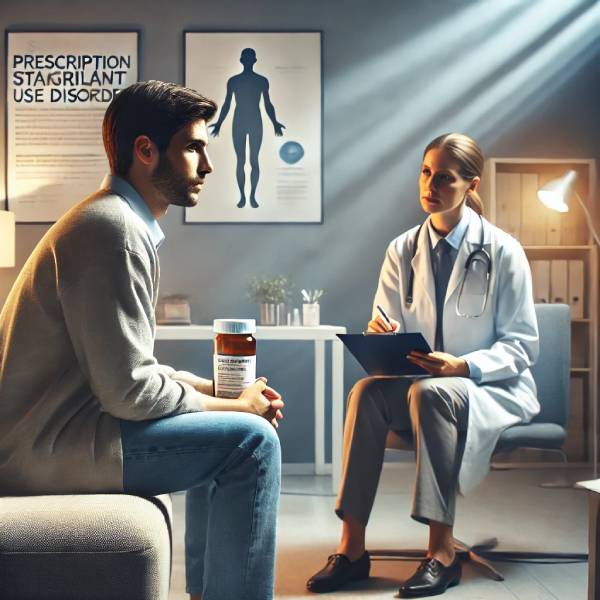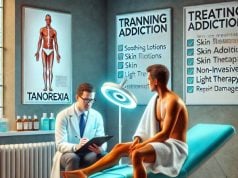
Prescription stimulants—best-known by brand names such as Adderall®, Ritalin®, Vyvanse®, and Concerta®—are powerful tools for managing attention-deficit/hyperactivity disorder (ADHD) and certain sleep disorders. When taken exactly as prescribed, they sharpen focus and improve quality of life. Yet the same dopamine-releasing punch that aids concentration can become a shortcut to all-night study sessions, weight loss, or a feel-good buzz. Over time, chasing that boost rewires reward circuits, driving cravings, tolerance, and a crash-and-burn cycle that affects work, relationships, and health. This guide unpacks how prescription stimulant use disorder develops—and how people find their way out.
Table of Contents
- Where, Why, and How Often It Happens
- Drivers Under the Hood: Causes and Risk Hotspots
- Spotting the Pattern: Behavioral Clues and Diagnostic Steps
- The Fallout: Body, Mind, and Social Life
- Turning the Corner: Evidence-Based Help and Sustainable Recovery
- FAQ
- Disclaimer
Where, Why, and How Often It Happens
A snapshot of prescription stimulant use
The modern era of stimulant medication began in the 1930s, but the real boom came in the 1990s with growing ADHD awareness. Prescriptions have climbed year over year, especially among teens, college students, and adults seeking productivity or wakefulness aids. Today, prescriptions for amphetamine and methylphenidate products number in the tens of millions annually.
- College campuses: Surveys show 10–20 % of undergraduates have used prescription stimulants non-medically, mainly to study longer or party harder.
- Workplace settings: High-pressure jobs—in finance, tech, healthcare—report rising “performance” use to power through deadlines or night shifts.
- Telehealth surge: Quick online consults have made obtaining a script easier, sometimes with minimal screening.
- Social media influence: TikTok, Reddit, and Instagram host countless anecdotes touting stimulants as lifestyle enhancers.
Measuring true prevalence is tricky
Prescription tracking systems capture legal fills, but non-medical sharing, trading, or online purchases remain underground. Self-report studies, toxicology screens, and treatment-admission data suggest that stimulant misuse has risen steadily, with a notable uptick since the COVID-19 pandemic, when remote learning and remote work blurred structure and sleep schedules.
Key takeaway: While most patients take stimulants responsibly, a sizable minority misuses them—fueling a growing use-disorder population that spans classrooms, living rooms, and boardrooms.
Drivers Under the Hood: Causes and Risk Hotspots
Prescription stimulant use disorder is rarely about a single bad choice. Instead, it unfolds where brain chemistry, personality, and environment collide.
Neurobiological hooks
| Mechanism | Impact |
|---|---|
| Dopamine surge | Amphetamines and methylphenidate block reuptake and spur release of dopamine and norepinephrine, producing alertness, euphoria, and reinforced learning of “pills = productivity.” |
| Tolerance build-up | Receptors down-regulate, so the same dose feels weaker; users add extra tablets or shorten intervals. |
| Withdrawal slump | When levels drop, fatigue, gloom, and brain-fog drive the urge to redose. |
Psychological catalysts
- Perfectionism and high achievement culture: Students and professionals feel constant pressure to perform; stimulants become a shortcut.
- Body-image concerns: Appetite suppression tempts some people seeking weight loss.
- Co-existing ADHD or depression: Improper self-adjustments (“a bit more can’t hurt”) spiral into misuse.
- Thrill-seeking temperament: Those wired for novelty crave the stimulant high.
Environmental accelerants
- Easy access: Leftover meds in family cabinets or traded among peers.
- Sleep-deprivation culture: “Hustle” environments glorify all-nighters.
- Digital peer reinforcement: Online forums share dosing hacks and syringe-conversion guides.
- Misconception of safety: Prescription label falsely signals lower risk versus street meth or cocaine.
Who is most at risk?
| Group | Why susceptibility is higher |
|---|---|
| College students in competitive programs | Academic deadlines, peer influence, ready supply. |
| Shift workers (healthcare, transportation) | Need to stay awake; long hours skew circadian rhythm. |
| Athletes cutting weight | Appetite crunch plus energy boost appeals during training season. |
| Individuals with untreated mental-health disorders | Self-medication to lift mood or concentration. |
Early education on healthy study habits, sleep hygiene, and emotional coping can buffer these risks.
Spotting the Pattern: Behavioral Clues and Diagnostic Steps
Because stimulants can look like productivity tools, misuse may masquerade as exceptional drive—until problems erupt.
Behavioral warning lights
- Dose escalation: Taking extra pills before exams, presentations, or workouts.
- Non-oral routes: Crushing and snorting tablets for faster kick, or dissolving for injection.
- “Study buddy” sharing: Trading pills among friends, sometimes for money.
- Sleep avoidance: Going 24–48 hours awake, then crashing hard.
- Medical “doctor shopping”: Multiple telehealth or urgent-care visits for refills.
Physical and emotional signs
| Phase | Common clues |
|---|---|
| Acute high | Dilated pupils, rapid speech, decreased appetite, elevated heart rate, sweaty palms. |
| Crash | Extreme fatigue, low mood, irritability, increased hunger, vivid dreams. |
| Chronic use | Weight loss, dental issues (dry mouth), anxiety spikes, tremors, hypertension. |
Withdrawal profile
After heavy use, withdrawal can last days to weeks:
- Profound tiredness and excessive sleep
- Depression or anhedonia
- Craving sweets or carbs
- Slow psychomotor performance
- Mood swings or agitation
Diagnostic process
A clinician confirms Stimulant Use Disorder when at least two DSM-5 criteria—such as tolerance, craving, hazardous use, or social impairment—appear within a year. Severity grading mirrors other substance disorders: mild (2–3 symptoms), moderate (4–5), severe (6+).
Assessment toolkit:
- Structured interviews—e.g., the Stimulant Use Disorder Symptom Checklist.
- Prescription Drug Monitoring Program (PDMP) data—flags overlapping scripts.
- Urine/blood screens—detect amphetamine or methylphenidate plus adulterants.
- Mental-health evaluation—identifies co-occurring ADHD, anxiety, depression, or bipolar disorder.
Pro tip: Invite a trusted friend or family member to share observations—outsider insight often reveals concealed behaviors.
The Fallout: Body, Mind, and Social Life
Physical consequences
- Cardio-vascular strain: Elevated blood pressure and heart rate increase risk of arrhythmias, stroke, or heart attack, particularly with underlying conditions or energy-drink mixing.
- Neurological effects: Chronic high doses may trigger tremors, tics, or seizures.
- Malnutrition and weight loss: Appetite suppression plus long waking hours erode muscle and immunity.
- Dental problems: Dry mouth and bruxism contribute to cavities and jaw pain.
- Sleep architecture disruption: Fragmented REM cycles impair memory consolidation and emotional regulation.
Psychological and cognitive toll
| Dimension | Impact |
|---|---|
| Mood | Anxiety, irritability, depression, or stimulant-induced euphoria followed by crash. |
| Paranoia and psychosis | High or binge doses can cause hallucinations, delusions, or violent outbursts. |
| Memory | Over-focusing on details but missing big-picture integration; long-term deficits emerge with heavy use. |
| Decision-making | Risky behaviors—impulse spending, unsafe sex, gambling—spike during intoxication. |
Social and functional ripple effects
- Academic misconduct: Cheating accusations or code-of-conduct violations for sharing controlled substances.
- Job performance swings: Short bursts of productivity offset by crashes, errors, or absenteeism.
- Financial drain: Paying street prices when prescriptions lapse.
- Relationship stress: Mood changes and sleeplessness cause conflict; loved ones worry about health and legal risks.
- Legal consequences: Possession of another person’s meds, forged scripts, or DUI can lead to arrest.
Bottom line: What starts as “extra help” quickly becomes a multi-system problem that steals health, joy, and opportunity.
Turning the Corner: Evidence-Based Help and Sustainable Recovery
Recovery is possible—and common—when treatment addresses biology, behavior, and context.
Step 1: Safe withdrawal and stabilization
Unlike opioids or alcohol, stimulants rarely cause life-threatening withdrawal, but professional monitoring eases the crash and detects complications.
- Gradual taper—reduces severity of fatigue and mood swings for heavy daily users.
- Symptom support—sleep hygiene coaching, nutritional boosts, hydration, mild exercise.
- Antidepressants or non-stimulant ADHD meds—bupropion, atomoxetine, or guanfacine may bridge focus without addictive risk.
Step 2: Core therapeutic approaches
| Modality | Focus | Sample technique |
|---|---|---|
| Cognitive-Behavioral Therapy (CBT) | Trigger recognition, thought restructuring | Challenge belief “I can’t succeed without stimulants.” |
| Contingency Management (CM) | Reinforce abstinence | Vouchers or prizes for negative drug screens. |
| Motivational Interviewing (MI) | Resolve ambivalence | Explore discrepancies between values (health) and behavior (misuse). |
| Dialectical Behavior Therapy (DBT) | Emotion regulation | Teach distress-tolerance and mindfulness to ride out cravings. |
| 12-Step or SMART Recovery | Peer support | Sober accountability partners and structured stepwork. |
Step 3: Addressing co-occurring conditions
- ADHD management: Non-stimulant medications, cognitive coaching, environmental structuring.
- Depression/anxiety: SSRIs, SNRIs, therapy, exercise, and sleep schedule restoration.
- Eating disorders: Nutrition counseling and body-image work if weight control drove misuse.
Step 4: Lifestyle rebuilding
- Sleep restoration—fixed bedtime, screen-light reduction, melatonin as needed.
- Nutrition repletion—protein, complex carbs, omega-3s to rebuild neurotransmitters.
- Exercise plan—aerobic and strength training boost natural dopamine and mood.
- Time-management skills—calendars, Pomodoro technique, realistic task chunking replace “cram and crash.”
- Digital hygiene—unfollow stimulant-glamorizing content; use focus apps rather than pills.
Step 5: Relapse-prevention toolkit
- Trigger log—identify stressors (exams, night shift, social pressure).
- Coping menu—breathing drills, brief walk, calling a friend, or journaling when cravings hit.
- Accountability network—recovery coach, sponsor, or supportive peer group.
- Regular check-ins—follow-up appointments, urine tests, mental-health screenings.
- Celebrate milestones—track sober days; reward with self-care treats or experiences.
Harm-reduction guidance for ambivalent users
- Limit dose and frequency—stick to prescribed amounts; avoid mixing with alcohol, cannabis, or other uppers.
- Avoid alternate routes—snorting or injecting dramatically increases addiction and overdose risk.
- Hydrate, eat, and sleep—mitigates strain on heart and mind.
- Never share tablets—sharing is both illegal and medically risky.
Hope note: Long-term outcome studies show that individuals who complete a structured program and maintain aftercare cut relapse rates by more than half compared with those who attempt self-detox alone.
FAQ
Can someone get addicted by taking stimulants exactly as prescribed?
Physical dependence is unlikely at therapeutic doses, but misuse may begin with small “booster” doses beyond prescription. Close monitoring and regular doctor visits keep usage safe.
How long does stimulant withdrawal last?
Fatigue and low mood peak within three days and usually subside in one to two weeks, but sleep issues and cravings can recur during high-stress periods for months.
Are there FDA-approved medications to treat stimulant addiction?
No medication is currently approved specifically for stimulant use disorder, but bupropion, topiramate, or naltrexone show promise when paired with behavioral therapy.
Do non-stimulant ADHD treatments work as well?
Atomoxetine, guanfacine, and behavioral strategies help many patients manage ADHD without addictive risk; some require a balanced combination plan.
Is occasional “study-drug” use really dangerous?
Even occasional misuse can trigger heart arrhythmias, sleep disruption, or legal consequences. It also normalizes chemical shortcuts, raising the likelihood of chronic use.
How can parents safeguard prescription meds at home?
Keep pills in a locked container, count regularly, never give meds to others, and dispose of leftovers at pharmacy take-back programs.
Disclaimer
The information provided here is for educational purposes only and should not substitute for individualized medical or mental-health advice. If you suspect prescription stimulant misuse or addiction, consult qualified healthcare professionals promptly.
If this article helped you, please share it on Facebook, X (formerly Twitter), or your favorite platform, and follow us for more science-backed, compassionate content. Your support enables us to keep creating resources that change lives—thank you!










